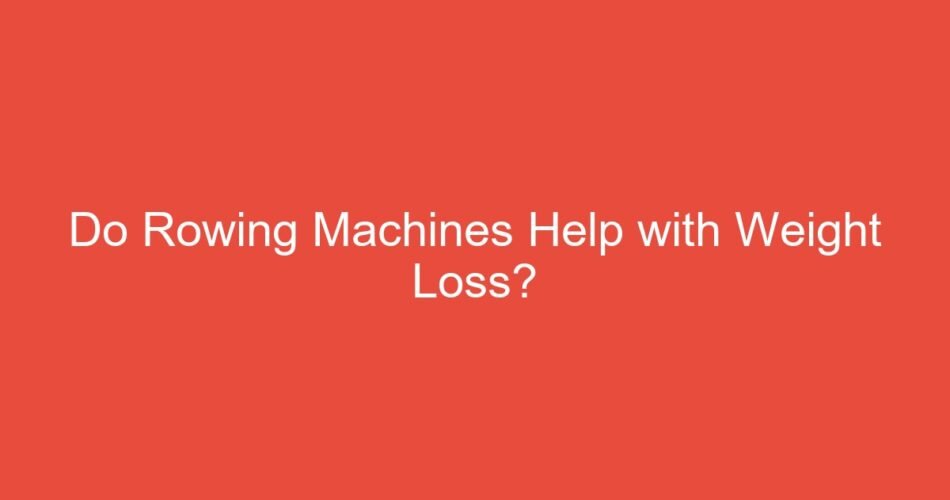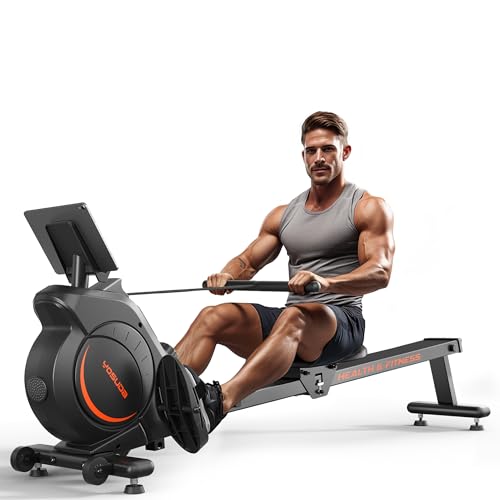Do Rowing Machines Help with Weight Loss?
Rowing machines are an outstanding tool for significant weight loss, uniquely combining high-intensity cardiovascular conditioning with superior muscle recruitment in a low-impact format.
Yes, rowing machines are incredibly effective for weight loss because they deliver an efficient, full-body workout that maximizes calorie burn and increases the body’s metabolic rate. If your goal is effective rowing machine weight loss results, this machine offers one of the best time-to-benefit ratios available in home or gym equipment.
🛒 Recommended Product
The Calorie-Burning Power of the Ergometer
The key factor determining whether do rowing machines help with weight loss is the rate at which they expend energy, and rowing excels in this area. A rowing machine—technically known as a dynamic ergometer—engages almost the entire body, leading to an extremely high expenditure of calories per session.
According to data compiled by Harvard Health Publishing, a 155-pound person performing vigorous rowing can burn approximately 372 calories in just 30 minutes. This places the ergometer on par with or superior to running at a 6 mph pace, but without the high-impact stress on the joints.
The intensity of rowing makes it ideal for maintaining a necessary caloric deficit. The higher the energy demand of an exercise, the faster you can achieve this deficit, making it a highly efficient method for fat loss.
Key benefits of rowing intensity:
- Elevated Heart Rate: Consistent, powerful strokes rapidly push the heart into optimal aerobic and anaerobic training zones, maximizing cardiovascular health benefits.
- Sustained Effort: Unlike weight training, which involves rest periods, rowing demands continuous work from large muscle groups, sustaining the calorie burn throughout the duration of the workout.
- Low Perceived Exertion: Because the movement is smooth and non-jarring, many users feel they can sustain high intensity for longer periods on the rower compared to running.
Total-Body Workout: Muscle Mass and Metabolic Rate
Weight loss is not solely dependent on burning calories during the exercise session; it is also determined by your basal metabolic rate (BMR). The BMR is the rate at which your body burns calories at rest, and this rate is directly proportional to the amount of muscle mass you carry.
Rowing is unique in the cardio world because it functions simultaneously as strength training. A proper rowing stroke recruits approximately 86% of the body’s skeletal muscles, targeting major groups in the legs, core, and upper body.
The muscle groups activated during the powerful four-part sequence (Catch, Drive, Finish, Recovery) include:
- Legs (60% of the power): Quadriceps, hamstrings, and glutes. These are the largest muscle groups, driving massive calorie expenditure.
- Core and Back: Erector spinae, traps, and abdominals, ensuring power transfer and stability.
- Arms and Shoulders: Biceps, deltoids, and lats, crucial for the pull phase.
By building and maintaining this muscle mass through consistent rowing, users naturally increase their BMR. This means they are burning more calories 24 hours a day, even when sitting, which is a significant factor in long-term, sustainable fat loss.
Maximizing Weight Loss: Integrating Training Strategies
To truly maximize the effectiveness of a rowing machine for weight loss, users must employ structured training protocols rather than simply rowing at a steady, moderate pace.
🛒 Recommended Product
The most effective techniques focus on varying intensity to trigger both immediate calorie burn and the post-exercise afterburn effect (EPOC).
Strategy 1: High-Intensity Interval Training (HIIT)
HIIT rowing involves short bursts of maximum effort followed by recovery periods. This method has been scientifically shown to elevate EPOC, meaning the body continues to burn extra calories for hours after the workout ends as it attempts to recover its resting state.
- Example HIIT Session: 45 seconds of maximum sprint rowing followed by 90 seconds of slow, easy recovery rowing. Repeat this cycle 8 to 10 times.
Strategy 2: Steady State Cardio (Endurance)
While HIIT is efficient, steady state rowing is crucial for building the underlying cardiovascular endurance necessary for sustained, long-term exercise adherence. This involves maintaining a consistent pace (often 65–75% of maximum heart rate) for 30–60 minutes. This method targets fat as the primary fuel source during the session.
| Training Protocol | Primary Fuel Source | Key Benefit for Weight Loss | Ideal Duration |
|---|---|---|---|
| HIIT Rowing | Carbohydrates/Glycogen | Maximizes EPOC (Afterburn) | 15–25 minutes |
| Steady State | Fat (after 20 min) | Builds foundational endurance, burns fat during exercise | 30–60 minutes |
Consistency is perhaps the single most important factor. Engaging in three to five targeted rowing sessions per week, combined with necessary dietary changes, ensures the caloric deficit required for successful weight loss.
Rowing vs. Other Cardio Machines
When people ask, “Do rowing machines help with weight loss?” they are often comparing them to treadmills or ellipticals. While all cardio machines can contribute to weight loss, the rowing machine holds specific advantages that make it an exceptional choice, especially for individuals with joint concerns or those seeking full-body conditioning.
1. Superior Muscle Recruitment
Treadmills and ellipticals are highly effective for cardiovascular conditioning but primarily focus on the lower body. The addition of the upper body, core, and back muscles into the rowing stroke means the body is forced to deliver oxygen and energy to a significantly greater portion of the anatomy. This dramatically increases the metabolic demand of the exercise.
2. Low-Impact Movement
Unlike running, which subjects the knees, ankles, and hips to constant pounding (sometimes equivalent to three times the body weight with each step), rowing is exceptionally low-impact. The user remains seated, and the movement is smooth and controlled, making it ideal for injury recovery, older athletes, or those dealing with chronic joint pain. This allows individuals to train harder and more frequently without risking overuse injuries, sustaining their weight loss regimen longer.
3. Functional Strength Integration
Rowing mimics the powerful, functional movement of lifting and pulling, engaging the posterior chain (the muscles on the back side of the body) which are often neglected in typical gym routines. Strengthening the posterior chain is vital for improved posture and overall athletic ability.
🛒 Recommended Product
Conclusion
The answer to Do Rowing Machines Help with Weight Loss is unequivocally yes; they are one of the most comprehensive and efficient pieces of equipment available for achieving fat loss goals. By offering a high-calorie-burning, full-body, low-impact workout that increases long-term metabolic rate through muscle building, the rowing ergometer stands out as a superior tool for sustainable weight management.
Scientific References & Research
The following peer-reviewed research papers provide additional scientific context:
-
A Ledvinkova (n.d.).
[HTML] Exercise Bike vs Rowing Machine: Which is Better for Weight Loss?
[External Link] -
GE Chapman (1997).
Making weight: Lightweight rowing, technologies of power, and technologies of the self
[External Link] -
H De las Casas et al. (2019).
Eccentric training with a powered rowing machine
[External Link]
Note: External research links are provided for educational purposes and do not necessarily represent endorsement.
Frequently Asked Questions About Do Rowing Machines Help with Weight Loss?
Q. Does the intensity of the rowing workout significantly impact the amount of weight lost?
A. Yes, intensity is a crucial factor in maximizing weight loss through rowing, as higher effort levels trigger the “afterburn effect” (EPOC), which keeps your metabolism elevated long after you stop exercising. Utilizing interval training (HIIT) on a rower, alternating between maximum effort sprints and recovery periods, is particularly effective for boosting fat oxidation. However, even consistent steady-state rowing at a moderate intensity over longer durations provides significant caloric deficit necessary for sustainable weight loss.
Q. Beyond calorie burning, what secondary physiological benefits of rowing aid in weight management?
A. Rowing helps build lean muscle mass, which is metabolically active and increases your basal metabolic rate (BMR), meaning you burn more calories even at rest. It also improves cardiovascular fitness, allowing you to sustain longer, more demanding workouts over time, thereby increasing the total weekly caloric expenditure. These metabolic and muscular adaptations are key to maintaining long-term weight loss rather than just achieving short-term results.
Q. Can rowing alone be sufficient for achieving significant weight loss results, or must it be combined with diet?
A. While rowing burns a significant number of calories, weight loss is primarily governed by achieving a consistent caloric deficit, which is extremely difficult to attain through exercise alone. Therefore, rowing must be combined with a healthy, calorie-controlled diet to achieve significant and sustainable results. Exercise aids weight loss by increasing expenditure and improving body composition, but nutrition dictates the foundational deficit required for losing fat mass.
Q. How important is proper rowing form to ensure maximum caloric expenditure and weight loss efficiency?
A. Proper form is paramount; poor technique dramatically reduces the involvement of large muscle groups like the glutes and back, shifting the load primarily to the arms and lower back, thus lowering the overall caloric burn. Efficient form ensures the powerful engagement of the legs (the largest muscle group), maximizing the physiological demand and translating directly into a higher, more effective weight loss workout. Furthermore, correct technique prevents injury, which is vital for maintaining the workout consistency necessary for successful weight loss.
Q. For individuals new to rowing, how should they structure their workouts to begin seeing weight loss results?
A. Beginners should start with 20-30 minute sessions three to four times per week, focusing first on mastering proper form at a steady, moderate pace (steady-state cardio). Once comfortable, they should introduce short bursts of higher intensity or beginner-level interval training to gradually increase metabolic demand and accelerate fat burning. Consistency and gradual intensity progression are far more important initially than trying to row intensely from day one, which can lead to burnout or injury.
Q. How does the low-impact nature of rowing benefit individuals with a large amount of weight to lose?
A. The low-impact nature of rowing makes it ideal for individuals with significant weight to lose because it provides an intense, full-body cardiovascular workout without the jarring impact on joints, such as the knees and ankles, that high-impact activities like running create. This reduces the risk of injury and pain, making it easier for heavier individuals to stay consistent with their exercise routine, which is the single most critical factor in achieving major weight loss success.
Related Articles
Which Cardio Machine Is Best for Weight Loss?
Deciding which cardio machine is best for weight loss depends on maximizing calorie burn and consistency. While several options are effective, two mac…
What Is the Best Workout Machine for Weight Loss?
Trying to determine what is the best workout machine for weight loss? While several options deliver results, the rowing machine often provides the max…
Do Vibrating Weight Loss Machines Work?
Do vibrating weight loss machines work? The scientific data is clear: while these vibration therapy plates offer proven benefits like muscle stimulati…
When you purchase a product through Amazon links on EllipticalKing.com, we may earn a small commission at no extra cost to you. This helps support the site and keep our content free.




